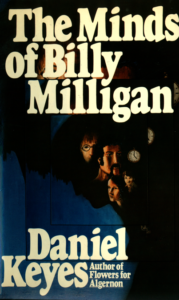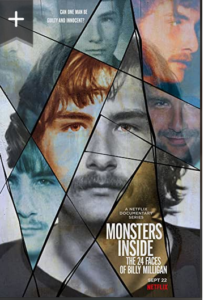Here’s the story…

The 2-hour documentary — “Billy” — was produced May-September in 1985. It was recorded in Athens, Lancaster, and Massillon, Ohio (where Milligan was being held in a state mental hospital.)


NOTE: The full, 2-hour documentary is not currently available to the public. If it becomes available, a notice will be posted here on this site. Meanwhile, below, you may watch a 6-minute video created with excerpts taken from the first hour of documentary.
Featured in these excerpts are:
- Daniel Keyes, co-author with Milligan of The Minds of Billy Milligan and The Milligan Wars (died in Florida from pneumonia in June, 2014, age 86)
- Dorothy Moore, Billy’s mother (died in Lancaster, Ohio, 2012 at age 83.)
- David Caul, M.D., Billy’s psychiatrist (died in Athens, Ohio, from a heart attack in 1988, age 66.)
- Billy Milligan, at age 30, interviewed while being held in the Massillon State Mental Hospital (died at East Mount Carmel Hospital in Columbus, Ohio, from cancer, December 12, 2014, age 59)
History of the Screenings of the Documentary…
In September 1985, with heightened interest from the Athens community, the full 2-hour documentary was scheduled for several screenings over several evenings on the public-access cable-television channel in Athens Ohio, where Billy Milligan had been treated for several years.
However, after the first 2 screenings, it was taken off the air with the arrival of a “cease and desist” letter from the county prosecutors, alleging there were libelous comments within the video. With the assistance of the ACLU and the advice of a local attorney, a censored version was allowed to be shown 3 times.
Then, in the summer of 1986, shortly after Milligan walked-away from a state mental hospital and “disappeared” for 139 days, Dr. David Caul screened the first hour of the documentary in Chicago for several hundred professionals attending the annual conference of the International Society for the Study of Multiple Personality Disorder (ISSMPD) — currently named The International Society for the Study of Trauma and Dissociation (ISSTD)
Then, for almost three decades, the program was safely locked away in a bank vault. During that time, private screenings were arranged for only 3 individuals between December 2014 and April 2015, following Milligan’s death. Since then, it has remained in a bank vault in Athens, Ohio.
– The Producer
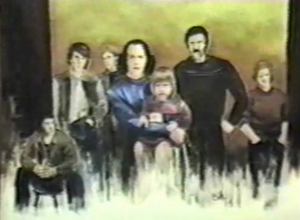
7 of Billy Milligan’s 24 Personalities as He Painted Them During Therapy: Allen, Tommy, Arthur, Adalana, Christene, Ragen, Kevin.
Overview:
After being arrested and found not-guilty (by reason of insanity) for 3 abductions and rapes in Columbus, Billy Milligan was sent by the Ohio court system to Athens, Ohio in December, 1978 to be treated for Multiple-Personality Disorder (MPD) — now called Dissociative Identity Disorder (DID). He was treated by Dr. David Caul at the Athens Mental Hospital located, at that time, in the historic Athens Lunatic Asylum. The asylum is currently a part of a complex of buildings now called “The Ridges.” [The state of Ohio gave the buildings and grounds to Ohio University which has transformed the central core of the asylum into The Kennedy Museum of Art.]

The “Athens Insane Asylum” Athens, Ohio, where Billy Milligan lived while he was being treated in the early 1980s.

The Athens Mental Hospital is now owned by Ohio University and is part of the complex of buildings called “The Ridges.” A portion of the building has been turned into The Kennedy Art Museum.
Billy Milligan’s 1984 guest appearance in the local, Athens television series, “45701.”

Below is the short, 3-minute sequence recorded in 1984 in which Billy (age 29) made a guest-appearance in the Athens Ohio local television series, “45701.”
At the time, he was living and being treated at the Athens Mental Health Hospital and his treatment had progressed so that he was being allowed unescorted visits out into the Athens community (which frightened and outraged many Athens residents — most of whom knew about him only as depicted in sensationalized newspaper headlines.)
It was thought that by inviting Milligan to appear in an episode of the popular, 15-part, Athens TV community “soap opera,” people might get to see him as a real person, and individual, rather than as “the Ohio State Rapist.”
Milligan was approached through his local attorney, invited to be in the program, and offered script-approval. He agreed to make a guest appearance as “himself” in the controversial series.
To avoid a curious public and any disruptions during production, the 2 scenes were videotaped secretly, with minimal crew, late on a Sunday night in the lobby of the main post office and in the city parking garage. (Fall, 1984.)
Because the excerpt is lifted out-of-context from the program’s storyline, it may not make a lot of sense. However, you will get to see one of Milligan’s personalities sketch a picture of the series’ main character, “Alan Starr.”
And, more importantly, you will get to see the “Billy Milligan” most people who knew him were familiar with.
Learn more about the “45701” Television Series HERE.

Billy Milligan (age 29) in October,1984 at the annual Halloween celebration on Court Street in Athens, Ohio. [from the “45701” archives]
Some Background about the Documentary,
Billy Milligan, and MPD/DID:
The excerpts in the 6-minute video (above) are taken from the first hour of a 2-hour documentary entitled “Billy.” It was produced in 1985 — halfway through his life — after Billy Milligan had been allowed to move out of the Athens Mental Health Hospital and live on his own in the community. At the time, he was having legal problems and was apparently the victim of alleged harassment from the county sheriff and the local prosecutors in Athens, Ohio.
NOTE: within the psychological profession, Multiple Personality Disorder (MPD) is now generally called Dissociative Identity Disorder (DID) though some professionals maintain there is difference between the two.
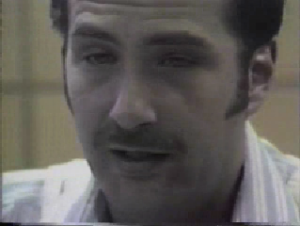
Billy Milligan (age 30 in 1985) when he was being held at the mental hospital in Massillon, Ohio.
William Stanley Milligan
(Feb 14, 1955 – Dec 12, 2014)
In the fall of 1977, while on parole after serving prison time for rape and armed robbery, “Billy” Milligan was arrested for committing a series of 3 rapes/robberies in the Columbus, Ohio area. The victims were abducted from the Ohio State campus and driven in their cars to Delaware county where they were raped and robbed.
While in custody awaiting trial, Milligan was diagnosed as suffering from Multiple Personality Disorder (MPD) and it was determined that the crimes were committed by 2 of his “alter” personalities: the armed robberies were committed by Ragen, the rapes were committed by Adalana, a lesbian personality. As a result, the judge ruled that he was “not-guilty by reason of insanity” and sent him to the state mental hospital in Athens, Ohio to be treated by Dr. David Caul, who had experience with treating “multiples.”
This was the first time someone in America had been acquitted of major crimes because they suffered from Multiple Personality Disorder. It was a controversial legal decision, especially since some professionals in the psychiatric field didn’t believe the disorder existed.
Multiple Personality Disorder, now generally called Dissociative Identity Disorder (DID), is usually caused by trauma, often severe child abuse. To protect itself, and to cope with the physical and emotional pain, the individual’s mind “leaves the scene,” splits, and sections-off traumatic memories. As a result, sometimes several personalities are created.
In Billy Milligan’s case, he alleged that when he was a child, he was sexually abused and buried alive by his step-father, Chalmer Milligan (Billy’s mother’s husband before she married Del Moore.) However, Milligan may have already been a “multiple” as early as age 3 or 4.
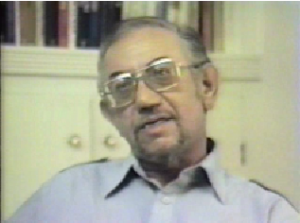
Daniel Keyes, author of The Minds of Billy Milligan talks about interviewing two of the three rape victims and his extraordinary experiences with Milligan while writing the book.
Multiple Personality Disorder (MPD)
In some cases, one personality will have no knowledge that the other personalities exist. All they know is that they “lose time” when they have blackout spells and “wake up” days, months, or years later when they are allowed to “take the spot.”
The personality who is conscious/aware and in charge of the body is said to be “in the spot” — a metaphor for standing in the spotlight of consciousness while the other personalities are off in the shadows (perhaps vaguely aware of what’s going on) or sleeping. (NOTE: Others suffering from this disorder may use different terminology — instead of “being on the spot” they may refer to a personality as “coming on the scene.”
Billy Milligan’s 24 personalities included a number of “undesirables” (some of them criminal or prankster personalities) who, because of the disruption or danger their past behaviors had posed to the group as a whole, had been “banned” from the spot by the stronger personalities.

In a sense, the various personalities acted as a dysfunctional “family” in which some personalities were more developed and “stronger” than others. During the best of times, Milligan might be able to control who took the spot.
During times of stress and chaos — “mix-up time” — undesirable personalities might seize the spot, commit crimes, or otherwise endanger the group. According to Ragen, Adalana seized the spot and committed the rapes without his knowledge.
Several of Billy’s personalities were artists, some were children, some were con artists and escape artists. Some spoke with foreign accents. Most were left-handed. A couple were female. For those with MPD or DID, some personalities may know about some of the others and even share their memories.
Apparently, during the robberies, Ragen was unaware of Adalana’s actions but she was aware of his — she watched from the sidelines as Ragen abducted women for the purpose of robbing them, and then, at an opportune moment, seized the spot to commit the rapes.
In Billy’s case, as a teenager, the “core Billy” (the original personality) had been put to sleep by the other personalities when he tried to jump off the roof of a school building and did not awaken again until receiving therapy after his arrest.
The sum total of all the personalities was called “The Teacher” who had the attributes and talents and memories of all the other characters. The Teacher emerged only occasionally, mostly during therapy.

More information about this psychological disorder can be found at the website for the professional organization dealing with Dissociation and Identity Disorders: The International Society for the Study of Trauma and Dissociation.
After the trial, with a great deal of media attention, Milligan was assigned to an Ohio state mental hospital (the Athens Asylum) where he could be treated by psychiatrist Dr. David Caul, an expert in the field of MPD.
While he was being treated, Athens resident (and English professor at Ohio University), Daniel Keyes (author of Flowers for Algernon which had been made into a motion picture called “Charly,” starring Cliff Robertson), collaborated with Milligan to write what became a best-selling book (available in 14 languages) entitled The Minds of Billy Milligan.
The two subsequently collaborated on another book entitled The Milligan Wars which has been published in Japanese in Japan but never published in English or in America. Apparently, its publication in the U .S. was tied to the release of the movie based on The Minds of Billy Milligan. The movie (titled The Crowded Room) has never been produced.

Published in Japan but not in America.
After being treated by Dr. Caul, Milligan was deemed well enough to move out into the Athens community (which was in-keeping with Ohio’s requirements that — as patients improve — they must be transferred to the least-restrictive environment that is proper for their condition.) Milligan rented a farm property just outside of Athens where he raised beef cattle and chickens but still had to check-in with the mental hospital each day.
However, his living out in the community caused a great deal of friction and fear among many of the local residents. This documentary was made during that period of time (1985) when the small, Athens community (a college town in southeast Ohio) became polarized over the idea of having a rapist, armed-robber, and mental patient living among them.
As with his appearance in “45701” it was thought that recording and cablecasting an interview with Milligan might provide the public with a better understanding than was being provided by the newspaper headlines and stories.
The initial interview with Milligan was expanded to include interviews with others who knew him — his neighbors, mother, doctor, and co-author. The program also included “on the street” interviews to represent the views and feelings of the Athens community. The original intention was never that it be a two-hour program. And the documentary was never meant to be seen outside of Athens, Ohio. It was made to help balance the negative publicity and to provide the Athens community with a broader (though admittedly favorably-biased) portrait of Billy Milligan.
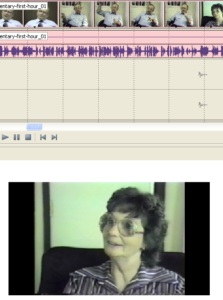
Billy Milligan’s mother, Dorothy Moore, describes the difficulties of raising a child with multiple personality disorder.
The first hour of the original documentary consists of extensive interviews with author Daniel Keyes, Dr. David Caul (Milligan’s therapist), Dorothy Moore (Billy’s mother), Del Moore (Dorothy’s husband at that time) and with Billy Milligan.
It also includes “on-the-street” interviews with a number of Athens citizens voicing their feelings (pro and con) about Milligan.
The second hour deals primarily with the local legal problems, harassment, and conflicts Milligan was encountering, including the consequences of having made the unwise decision to rent a farm property right next door to the county sheriff who publicly stated that he was going to put Milligan back in prison, where he belonged.
After several encounters with the authorities, Milligan was sent to other state-operated hospitals.
On July 4th in the summer of 1986, Milligan walked away from the Central Ohio Psychiatric Hospital in Columbus and was missing for more than 4 months.

Finally, on Thursday, November 20, 1986, the FBI arrested Billy Milligan in the bar of the Key Biscayne Hotel and Villas, south of Miami. He was held in the Miami Metropolitan Correctional Center in Dade County, without bond, until December 10th when he was escorted back to Columbus, Ohio. There, he was assigned to the Timothy Moritz Forensic Center in Columbus (Ohio’s maximum-security facility for the criminally insane.)
For several months at the Moritz Center he received no treatment and staged a hunger strike.
Then, months later, after a consulting psychiatrist skilled in working with MPD patients examined him and declared that he found no evidence of multiple personalities, Milligan was released.
To raise funds, in October, 1989, Milligan sold some of his paintings and artwork through an art exhibit held at the Brenda Kroos Gallery in Columbus.
By August, 1991, the terms of his parole had been completed and Billy Milligan was discharged by the Ohio mental health system and by the Ohio court system.
Though he left Ohio in the early 1990s, his legal problems continued as the state of Ohio made legal efforts to collect payment from Milligan, having billed him for the several years of housing and therapy (plus interest) which they had provided during his treatment at the various state hospitals where he was legally confined.
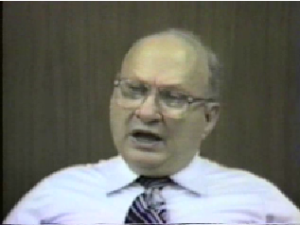
Dr. David Caul, Billy Milligan’s psychiatrist in Athens, Ohio, who also released Milligan into the Athens community, explains the phenomenon of Multiple Personality Disorder and his experiences of working with Milligan as a patient.
For a while, Milligan lived in the Los Angeles area where he started a film production company called Stormy Life Productions, though it is not known whether the company ever created any films. Also, in the 1990s, while living in San Diego County, Milligan was accused of threatening a judge and went through bankruptcy proceedings in 1996 which lasted until the year 2000.
For over 20 years, there was talk of a Hollywood movie based on Milligan’s story but after several false starts, the projects were all abandoned. Film director, James Cameron (Titanic, Terminator, Avatar), planned a movie called “A Crowded Room” (READ THE SCRIPT HERE) which was based on the Keyes book, The Minds of Billy Milligan. However, after the owner of the film-rights to the book sued, asking for more money, and after Milligan, himself, filed a lawsuit against Cameron, the film director dropped the project.
Other names associated with the abandoned Hollywood efforts include director Joel Schumacher and various actors considered to portray Milligan including Leonardo DiCaprio, John Cusack, Brad Pitt, Matthew McConaughey, Johnny Depp, and Sean Penn. Milligan coached some of these actors on multiple personality disorder.
For over 20 years (from the late 90s until his death in December, 2014), Milligan’s whereabouts were largely unknown (except to his family.)
However, after he died from cancer (soft tissue sarcoma) on December 12, 2014 at East Mt. Carmel hospital in Columbus, Ohio, Billy’s younger sister, Kathy, stated that he had been living fairly quietly in the Columbus area for the previous 5 years.
In early 2015, 3 months after Milligan’s death, Leonardo DiCaprio announced he would play Billy in the slightly-retitled “The Crowded Room“ — still based on the Keyes book.
Shortly after DiCaprio’s announcement, Milligan’s sister gave a rare interview to a Columbus television station:

Milligan’s younger sister, Kathy, responded to Leonardo DiCaprio’s announcement that he would play the role of Billy Milligan in a feature film.
DiCaprio’s movie was to be scripted by Jason Smilovic and Todd Katzberg and would be a co-production of New Regency and DiCaprio’s Appian Way Productions. To date, the film has not gone into production.
Then, in 2016, director M. Night Shyamalan released SPLIT — a horror/thriller film starring James McAvoy — which was apparently, very loosely, based on the Milligan character.
____
Want to learn more?
Read ‘The Strange Case of Billy Milligan’s Jigsaw Psyche‘ in The Columbus Monthly, (February, 1979.)
This article details the life of Billy Milligan up until his 1978 trial and describes the media frenzy and the skepticism held (at that time) about the MPD diagnosis among some professionals in the psychological community.
And read the book:
The Minds of Billy Milligan
_________

Watch the 4-part NETFLIX Documentary Series
Monsters Inside: The 24 Faces of Billy Milligan
(released in September 22, 2021)
To watch the trailer at Netflix, click the image below…
_______
In June, 2023, Apple.TV releases The Crowded Room — a 10-Part Series starring Tom Holland — based on Daniel Keyes’ play of the same name and the book, The Minds of Billy Milligan. For over 30 years, options and rights to The Crowded Room have bounced around Hollywood but it was never filmed. Many producers/directors struggled with how to visualize the different personalities on-screen without confusing the audience. Maybe Apple.TV has deciphered the code. Click the image below to watch the trailer at Apple.TV.
NOTE: This site last updated on May 20, 2023
_________
Copyright 2019 – 2023, All rights reserved.
